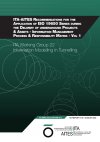Digital enablement of infrastructure can be delivered by the application of Building Information Modelling (BIM), Digital Engineering, Asset Information Modelling or Virtual Design and Construction. This document adopts the broadest possible interpretation of ‘BIM ‘, and therefore covers all the above principles.
BIM is not only a digital representation of physical and functional characteristics of a building, piece of physical infrastructure or environment but also a comprehensive environment for all information fully referenced and indexed to allow multiple access points for users of information to find relevant content. As such, BIM serves as a shared knowledge resource for information about an asset throughout its lifecycle—supporting decision making—from strategic appraisal and planning, design and construction to operation, maintenance, and renewal. BIM enables a collaborative way of working using digital processes to facilitate more productive methods of planning, designing, constructing, operating, and maintaining assets through their lifecycle.
Governments globally recognise the importance of BIM in the delivery and management of infrastructure assets as it offers many benefits throughout the asset lifecycle and has the potential to drive efficiency, value for money, productivity, innovation, and safety.
However, a clear framework is required to help adoption, integration, and application of BIM processes in construction industry. In this context, the ISO 19650 series propose a standard framework for information management of built assets using information modelling processes applicable throughout the asset life cycle.
In current Information Management Systems used throughout the different stages of a built asset development, the information is captured, represented, produced, processed, and stored in documents, databases, analysis, and design tools, and other “information containers” using processes, methods and tools specified separately for each given project and each milestone by the information owner or receiver. These containers are exchanged between different parties involved in the project for different purposes such us analysis, interpretation, review, check, approval, quantity take-off, construction, management, planning, budgeting, pricing, forecasting, predicting, or other activities carried out during the asset life cycle. The ISO 19650 series propose to use 3D models as part of a “central information container” of the asset information. The models inherently contain the geometrical information of the asset entities and parts and their special locations. Other information can be added to each part of the model, these are called meta-data. Other type of information containers like reports, factual data, specifications, suppliers or other data sheets, drawings, (etc., referenced, or using hyperlinks) to each part of the model to complement the meta-data information. The information details required to be captured and stored in the model depends on the required activity (to be performed using the model) and the stage of the asset life cycle. For example, if design check activity is carried out using the model, the modelled information, the associated meta-data, and the linked documentation should be attributed to a package containing the design information needed the design information needed to perform the required design check activity. To carry out scheduling activity using a model, the production rates of each part of the model are needed to be added as meta-data. As such, every information contained in the model, either geometrical, meta-data or linked documentation responds to a need to carry out a design, construction, operational or other asset related activity at a given stage of the asset life cycle. The need, the type of activity and the stage during which the activity is carried out define the level of details to be brought into the model.
The following sections summarise the ISO 19650 concepts and propose a high-level process for information management and an information Management a stage-by-stage Responsibility Matrix to ISO 19650 applicable for underground assets

